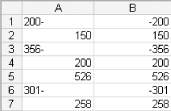Say you have a long list of numbers you just imported and some of them are those so-called negative numbers. Your job is to convert these to valid negatives that Excel will recognize. For the purposes of this exercise, you will use the range A1:A100. In cell B1, enter this formula:
=SUBSTITUTE(IF(RIGHT(TRIM(A1))="-",RIGHT(TRIM(A1))&A1,A1),"-","",2)+0
Enter this as many cells down the column as needed and then copy them and select cell A1. Select Edit » Paste Special... » Values to remove the formula and retain the values only. Figure shows a before-and-after example (A1:A7 represents before).
Figure. Before and after moving the negative sign

To give you an idea of how the formula works, enter the following formula in any cell where A1 has the text 200-:
=RIGHT(TRIM(A1),1)&A1
You will end up with -200-.
The TRIM function simply ensures that there are no space characters in the cell. As you end up with -200-, you need to remove the second occurrence of the negative sign. This is what the SUBSTITUTE function is doing. You told it to substitute the second occurrence of - with "" (empty text). The result returned is actually text (as that is what the SUBSTITUTE function returns), so you simply use +0, and Excel will convert it to a number.
If you need to do this frequently, you should consider a macro to make the job easier. Here is one that will do the task at hand. It has been optimized for speed.
Sub ConvertMirrorNegatives( )
Dim rCell As Range
Dim rRange As Range
Dim lCount As Long
Dim lLoop As Long
'Ensure they have the data selected and display a message if they _
don't, then exit the macro.
If Selection.Cells.Count = 1 Then
MsgBox "Please select the range to convert", vbInformation
Exit Sub
End If
'Set a variable to ONLY text cells, e.g., 200-
On Error Resume Next
Set rRange = Selection.SpecialCells(xlCellTypeConstants, xlTextValues)
'If our variable returns Nothing, there are no incorrect negatives _
so display a message, then exit the macro
If rRange Is Nothing Then
MsgBox "No mirror negatives found", vbInformation
On Error GoTo 0
Exit Sub
End If
'Count just how many cells are like 200- and pass this number _
to a variable to control how many loops are needed.
lCount = WorksheetFunction.CountIf(Selection, "*-")
'Set a variable to the first cell in the selection
Set rCell = Selection.Cells(1, 1)
'Loop only as many times as there are incorrect negatives
For lLoop = 1 To lCount
'At each loop set a variable to the cell housing *-
'The asterisk is a wildcard character
Set rCell = rRange.Find(What:="*-", After:=rCell, _
LookIn:=xlValues, LookAt:=xlPart, _
SearchOrder:=xlByRows, SearchDirection:= _
xlNext, MatchCase:=False)
'Use the standard Replace feature to replace the negative sign _
with nothing. In other words, we remove it.
rCell.Replace What:="-", Replacement:=""
'Multiply the cell by -1 to convert it to a negative number
rCell = rCell * -1
Next lLoop
On Error GoTo 0
End Sub
To use this macro, select Tools » Macro » Visual Basic Editor (or Alt/Option-F11). Now select Insert » Module and paste in the preceding code. Close the window to return to Excel and select Tools » Macro » Macros, and then select Convert Mirror Negatives. Click Options and assign a shortcut key. Now when you have to convert those imported negatives to true negatives that Excel will recognize, simply select the figures and use your shortcut key.